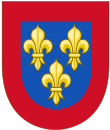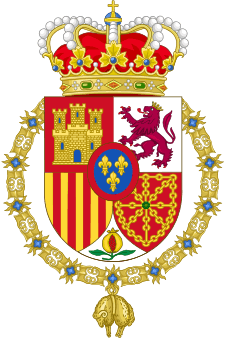Spanish royal family
| Spanish royal family |
|---|
 |
|
HM King Juan Carlos I
Extended royal family
HRH The Duchess of Soria and Hernani
|
| Bourbon-Anjou Bourbon-Spain | |
|---|---|
| Spanish royal family | |
 | |
| Parent house | House of Bourbon |
| Country |
Former countries
|
| Founded | November 16, 1700 |
| Founder | Philip V |
| Current head | Felipe VI |
| Titles | |
| Style(s) |
"His/Her Majesty" "His/Her Royal Highness" "His/Her Excellency" |
| Motto |
Plus ultra (Latin for "Further beyond") |
| Estate(s) |
Royal Palace of Madrid (seat) Royal Palace of El Pardo (private residence) El Escorial Royal Palace of Aranjuez La Granja Royal Palace of Riofrío Royal Palace of La Almudaina |
| Deposition |
Spain:
Naples, Sardinia, Sicily, Milan, Lothier, Brabant, Limburg, Luxemburg, Namur, Flanders, Hainaut:
Parma:
Two Sicilies:
|
| Cadet branches |
Bourbon-Parma Bourbon-Two Sicilies |
The House of Bourbon-Anjou[1][2][3] (or simply House of Bourbon-Spain) is the reigning royal house of the Kingdom of Spain. The current Spanish royal family consists of the present king, the queen consort, their children and the king's parents. The House of Bourbon-Anjou is a branch of the House of Bourbon that descends from Philip V of Spain.
Titles and styles
The titles and styles of the Royal Family are as follows:[4]
- The occupant of the Throne is The King or The Queen, together with other titles pertaining to the Crown or belonging to members of the Royal Family. They are styled His or Her Majesty.
- The King's wife bears the title of Queen with the style Her Majesty.
- The husband of the Queen regnant bears the title of Prince and is styled His Royal Highness.
- The King's heir apparent or heir presumptive bears the title of Prince or Princess of Asturias with the style His or Her Royal Highness.
- A King's sons and daughters, not being the Prince or Princess of Asturias, as well as the children of the Prince or Princess, bear the title of Infante or Infanta of Spain, and are styled as His or Her Royal Highness. The children of an Infante or Infanta have the rank (but not the title) of Grandees, and the style of His or Her Excellency.
- Spouses and widows/widowers of the monarch's sons and daughters, other than those of the Prince or Princess of Asturias, are entitled to the form of address and honours the monarch may grant them.
- The sovereign may also grant the dignity of Infante or Infanta with the style of Highness.
- If the heirs of King Juan Carlos I were to be extinguished, the 1978 Constitution reserves the right for the Cortes Generales to designate the successor to the throne as may be suitable for Spain.
Members of the Royal Family
- King Felipe VI, the monarch
- Queen Letizia, the King's wife
- Leonor, Princess of Asturias, the King's elder daughter and heir presumptive
- Infanta Sofía, the King's younger daughter
- King Juan Carlos, the King's father and predecessor
- Queen Sofia, the King's mother
Members of the King's Family
- Infanta Elena, Duchess of Lugo, the King's eldest sister
- Felipe de Marichalar y Borbón, the King's nephew
- Victoria de Marichalar y Borbón, the King's niece
- Infanta Cristina, the younger of the King's sisters
- Iñaki Urdangarin, the King's brother-in-law
- Juan Urdangarín y de Borbón, the King's nephew
- Pablo Urdangarín y de Borbón, the King's nephew
- Miguel Urdangarín y de Borbón, the King's nephew
- Irene Urdangarín y de Borbón, the King's niece
- Infanta Pilar, Duchess of Badajoz, the King's aunt
- Simoneta Gómez-Acebo y de Borbón, the King's cousin
- Juan Gómez-Acebo y de Borbón, Viscount de la Torre, the King's cousin
- Bruno Gómez-Acebo y de Borbón, the King's cousin
- Luis Gómez-Acebo y de Borbón, the King's cousin
- Fernando Gómez-Acebo y de Borbón, the King's cousin
- Infanta Margarita, Duchess of Soria, the King's aunt
- Carlos Zurita, Duke of Soria, the King's uncle
- Alfonso Zurita y de Borbón, the King's cousin
- María Zurita y de Borbón, the King's cousin
House of Bourbon-Two Sicilies
Royal family tree
- Notes
* - Member of the Royal Family (as opposed to the Family of the King, or extended family)
** - Member of the Extended royal family
Public role
Members of the Spanish Royal Family are often asked by non-profit charitable, cultural, or religious organizations within and without Spain to become their patrons, a role the Spanish constitution recognizes and codified in Title II Article 62 (j). It is incumbent for the monarch "to exercise the High Patronage of the Royal Academies".[5] Royal patronage conveys a sense of official credibility as the organization is scrutinized for suitability. A royal presence often greatly raises the profile of the organization and attracts media publicity and public interest that the organization may not have otherwise garnered, aiding in the charitable cause or cultural event. Royalty make use of their considerable celebrity to assist the organization to raise funds or to promote government policy.
Additionally, members of the royal family may also pursue their own charitable and cultural interests. Queen Sofía devotes much of her time to the Queen Sofia Foundation (Fundación Reina Sofía);[6] while King Felipe chairs the Prince of Asturias Foundation (Fundación Príncipe de Asturias), which aims to promote "scientific, cultural and humanistic values that form part of mankind's universal heritage."[7]
The Prince of Asturias Foundation holds an annual awards ceremony acknowledging the contributions of individuals, entities, and/or organizations from around the world who make notable achievements in the sciences, humanities, or public affairs. King Felipe serves as president of the Codespa Foundation, which finances specific economic and social development activities in Latin American and other countries, and serves as president of the Spanish branch of the Association of European Journalists, which is composed of achieving communications professionals.[8] King Felipe also serves as honorary chair of the Ministry of Culture National Awards Ceremonies.[9]
Infanta Elena, Duchess of Lugo, Juan Carlos' elder daughter, is the Director of Cultural and Social Projects of Mapfre Foundation,[10] while Infanta Cristina, Juan Carlos' younger daughter, served as the Goodwill Ambassador to the United Nations for the 2nd World Assembly on Ageing, and is a member of the Dali Foundation Board of Trustees, president of the International Foundation for Disabled Sailing, and Director of Social Welfare at the La Caixa Foundation in Barcelona where she lives with her family.[11]
King Juan Carlos, Queen Sofia, and Infanta Cristina are all members of the Bilderberg Group, an informal think-tank centered on United States and European relations, and other world issues.[12][13][14]
See also
References
- ↑ Feal Vázquez; Javier (2003). "Los símbolos de la Patria" (PDF).
- ↑ Fernández-Xesta y Vázquez; Ernesto (2012). "La heráldica familiar". ISSN 1137-1056.
- ↑ Campos Pérez; Lara (2009). "Iconografía de la idea de España en los manuales escolares durante la transición a la democracia (1976-1983)". pp. 109–130. ISSN 0214-400X.
- ↑ Royal Decree 1368/1987, dated 6 November, regulating titles, forms of address and honours pertaining to the Royal Family and to the Regents Boletín Oficial del Estado (BOE)
- ↑ 1978 Spanish Constitution. Part II. The Crown
- ↑ Queen Sofia Foundation
- ↑ Prince of Asturias Foundation
- ↑ Codespa Foundation Archived 2009-05-04 at the Wayback Machine.
- ↑ Delivery of the National Awards of the Ministry of Culture 2008
- ↑ Infanta Elena
- ↑ Infanta Cristina
- ↑ Mark Oliver (4 June 2004). "The Bilderberg group". The Guardian.
- ↑ "Bilderberg Meeting of 1997 Assembles". PR Newswire. 13 June 1997. Archived from the original on 30 April 2011.
- ↑ "Bilderberg Group Meets In Athens Amid Tight Security". NASDAQ.
